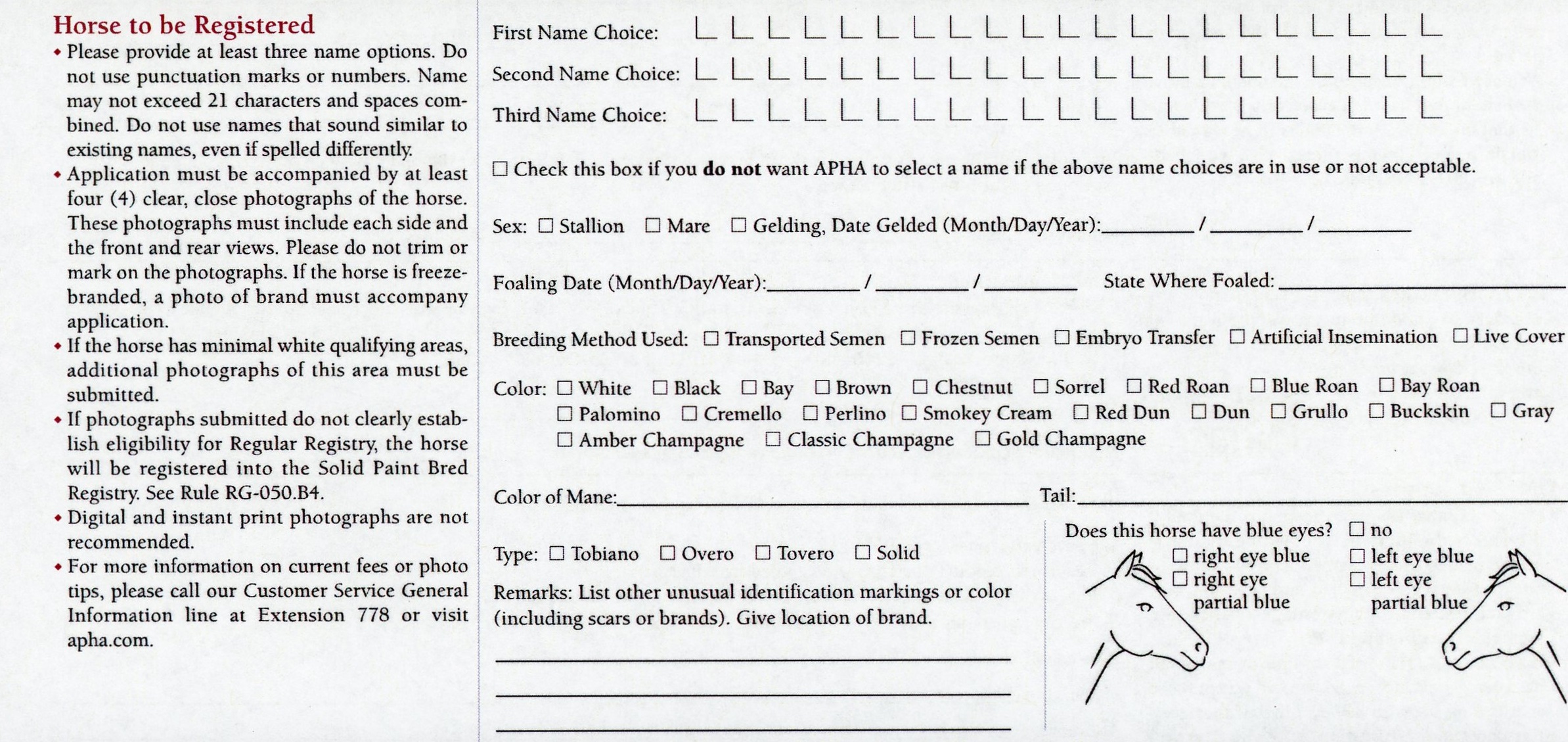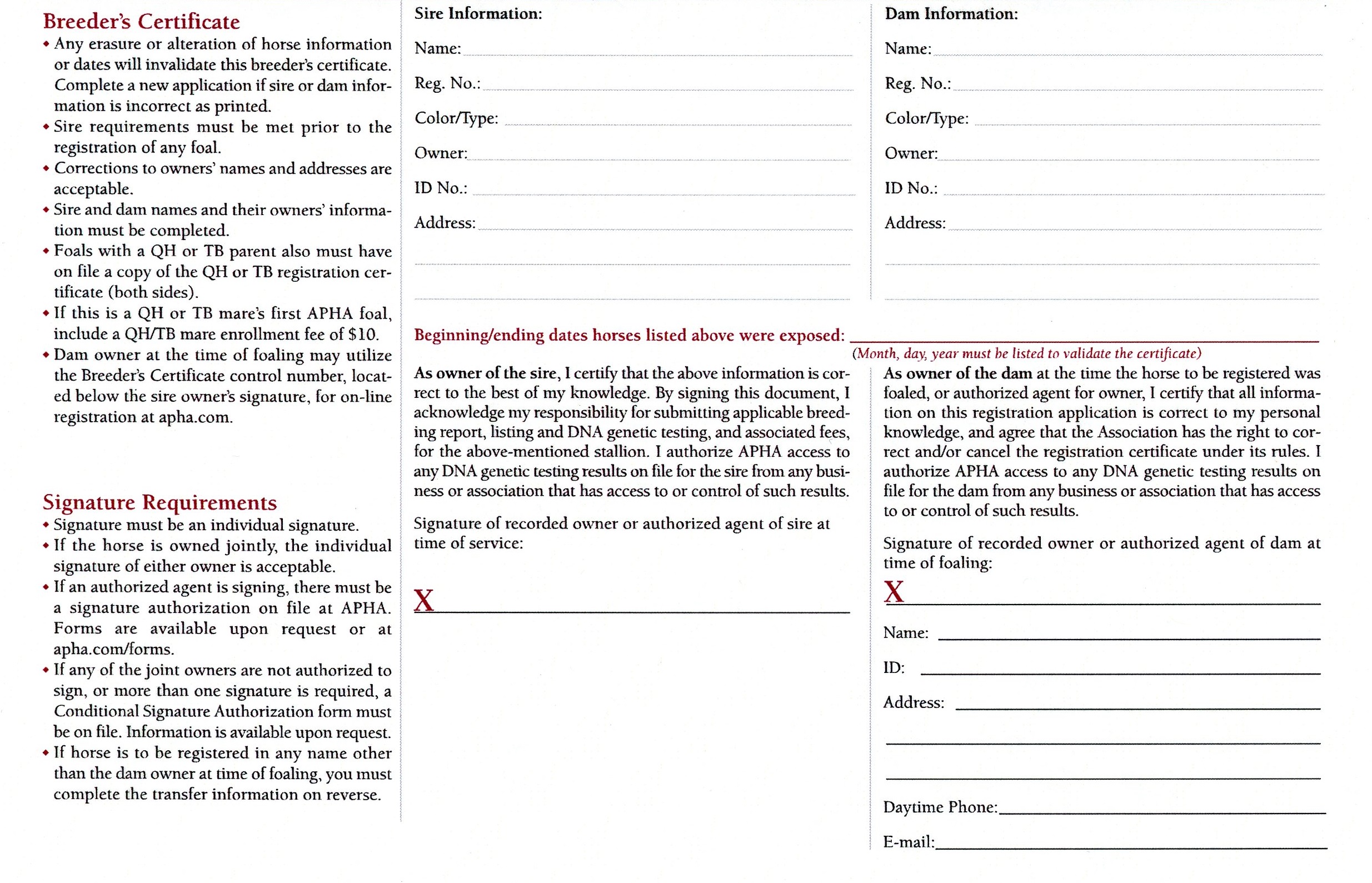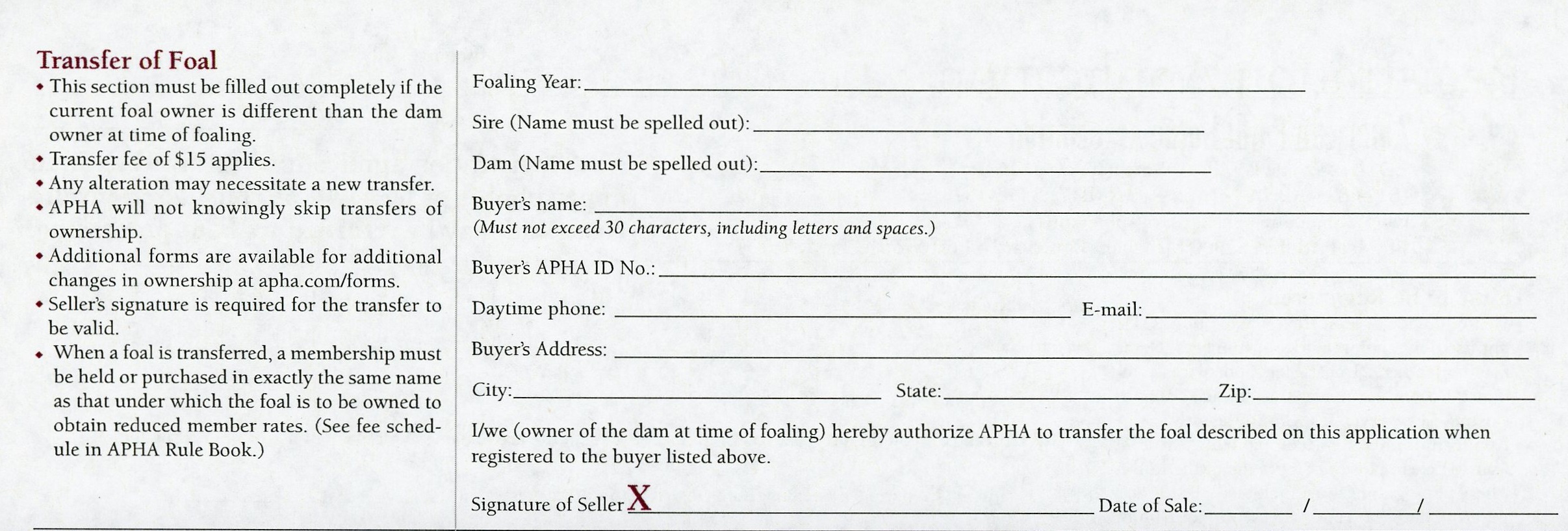How to Register a Paint Horse
The most important document you may ever complete as a horse owner is a registration application. Completing this form accurately will reduce the time it takes to process a registration. We will walk you through the registration application, step by step. You can download the registration application or request one be mailed to you by contacting us at the address below.
Keep in mind that giving false information to the association, particularly in Sections 2 and 3 of the application, may carry severe penalties.
You may pay a rush fee to have the registration processed more quickly than the normal processing time.
Who is responsible for registering a foal?
The owner or lessee of the dam at foaling is responsible for registering that foal. This person is automatically recorded as the original owner of the foal on the registration application and certificate. If the application is accompanied by a signed transfer, the new owner will be contacted for more information if needed.
Section 1: Information on the Horse to be Registered

Section 1 of the registration application asks for basic information about the horse. As most horses are registered when they are foals, we will use both “horse” and “foal” interchangeably.
List three name choices in the spaces provided. You may not use punctuation marks, numbers, Roman numerals or profanity in the name. The name may not exceed the number of spaces on the application.
Also, no two horses registered by the association may have the same name or a name that sounds similar. If the APHA determines that your choice is too similar to another name already in use, the name will be disqualified and your next selection will be considered.
If you do check the box directly beneath the name choices and your three selections are already taken or not acceptable, we will contact you for another choice. By not checking this box, you allow APHA staff to choose a name for you. This helps avoid delays.
Check the appropriate box to indicate the sex of your horse. If you are registering a gelding, you need to provide the exact date (month/day/year) the horse was gelded.
List the month, day and year on which the foal was born. This date should correspond to the breeding dates listed in Section 2 of the registration application. The normal gestation period for a horse is 11.5 months (345 days). If you do not know the exact date of birth, estimate the foaling date as closely as possible.
List the state, province or country in which your horse was foaled. If omitted, the APHA records that the horse was foaled in the state or country in which the mare owner resides. This may be important if your state, province or country offers any incentive programs for breeders.
Check the box that best describes the primary color of your horse. Use the color descriptions Coat Colors to help you identify the color. If your horse is predominantly white, check the color that best describes the horse’s contrasting area. Regardless of the amount of color, the dark hair always determines Paint color, never by the white. Of course, it is possible that your horse is solid white. In this case, your horse may be eligible for the Breeding Stock Registry.
Check the box that best describes your horse’s type of coat pattern: tobiano, overo, tovero or solid. If you are unsure, read the coat pattern descriptions on this site or leave it blank. Registration staff will determine the coat pattern for you after reviewing the photos.
Does this horse have blue eyes? Check the appropriate box(es): no, right eye blue, right eye partial blue, left eye blue, or left eye partial blue.
In the space provided, indicate any brands or scars that could be used to identify the foal. If your horse is freeze-branded, send a photograph of that brand with your application. That information will become a permanent part of your horse’s file.
Section 2: Breeder’s Certificate and Original Owner

Section 2 of the Registration Application is the Breeder’s Certificate. Some information in this section may be pre-printed on registration applications, based on information provided by the Stallion Breeding Report.
You must have the recorded stallion owner at the time of breeding sign the Breeder’s Certificate or release the breeding online before the foal can be registered.
The name and registration number of the sire of the foal should be provided under ‘sire information’. Directly underneath that space is a box for information about the sire’s color and type. As this information is listed on the sire’s registration certificate, the stallion owner should have no trouble completing these sections.
The stallion owner should provide the same information on the dam, including her registered name, identification number, color and type and the name and address of the owner of the mare at the time of breeding. The owner or lessee of the dam at the time of breeding is considered the “breeder” and is recorded as such on the registration certificate. If the dam is a Quarter Horse or Thoroughbred, include a copy of both sides of the AQHA or Jockey Club registration certificate.
The stallion owner must include the breeding dates or the period of exposure. Keep in mind that the mare may have been bred more than once to get her in foal. Therefore, the dates should include the period of time between the first and last exposure. If the mare was pasture-bred, the dates should begin with the day the mare was first turned into the pasture with the sire, as well as the date she was removed.
These dates must match the dates listed on the stallion breeding report or there may be delays in processing the application.
The owner of the stallion at the time of breeding must sign the Breeder’s Certificate or release the breeding online. By signing this document or releasing the breeding, the stallion owner certifies that the information on the application is correct and that the mare owner has satisfied the breeding agreement. If you are the record owner of both the sire and the dam at the time of breeding and foaling, you must fill out Section 2 but only need to sign as the original owner of the foal.
Section 2: Original Owner of the Foal
Section 2 also contains the signature block for the original owner of the foal. APHA rules state that the original owner of the foal is the record owner or lessee of the mare at the time of foaling. This person should complete the lower right hand corner of Section 2 and sign where indicated. Ownership of the foal, and membership, must be in exactly the same name as the dam is owned. If you buy the foal from the mare owner, you need to get the mare owner to complete Section 2 of this application and sign Section 3, the transfer section.
Provide the mare owner’s name and APHA identification number if you know it.
The mare owner should sign the application where it calls for signature of “recorded owner or authorized agent of dam at time of foaling”. By signing this certificate, the mare owner guarantees that the information is accurate to the best of their knowledge. Their current mailing address should be provided.
Section 3: Transfer of Foal

If you are not the original owner of the foal, you need to transfer ownership from the owner or lessee of the mare at the time of foaling to yourself. To do this, you must complete Section 3 and pay the appropriate transfer fee.
A transfer is simple to complete. As the buyer, you need to provide your name, your APHA identification number if available, your telephone number and your current address. Though membership is not required to transfer ownership, substantially higher fees are charged to non-members. If you are not a member and choose not to become a member, simply include, along with your application, a signed statement to that effect and pay the higher fees for the registration and the transfer.
To complete the transfer, you need to record the date of the sale and get the signature of the owner of the dam at the time of foaling. Remember that the owner of the dam at the time of foaling is automatically the original owner of the foal. If you have purchased the foal from the dam owner prior to its registration, you must transfer ownership into your name.
Forgetting the mare owner’s signature in Section 3 is a common mistake. To avoid delays in processing, be sure you get the signature of the mare owner on the transfer report.
What signatures do I need?
Proper signatures are extremely important. As for signatures, the owner or any one of the joint owners of a horse can sign the application. The most frequent mistakes that result in a processing delay involves the wrong signature. Read the instructions carefully to make sure you are getting the correct signature in the proper place.
Printed signatures are not acceptable. Whoever signs the application must sign with an individual written signature. For example, the foal may be registered to “John and Mary Jones.” The APHA membership must be carried as “John and Mary Jones.” However, the application must be signed by “John Jones” or by “Mary Jones” or as “John and Mary Jones by John Jones” or “John and Mary Jones by Mary Jones.” No other variations on the signature are acceptable.
In the event that a farm, partnership or corporation owns the horse you want to register, a signature authorization card must be on file with the APHA. This card identifies the authorized people allowed to register, transfer or conduct business for that entity. A registration application cannot be completed until this card is filed. You can download the form from this web site. The current APHA Official Rule Book will list the appropriate fee.
Section 4: Other services

The American Paint Horse Breeders’ Trust Program provides added incentives for Paint Horse owners to exhibit their horses in the show arena. Nominated horses are paid cash dividends for points earned at APHA-approved events, and everyone responsible for the success of an outstanding foal is rewarded. The stallion owner, foal nominator and horse’s owner all share in the profit. By completing this section and submitting the appropriate fees, you can nominate a foal that was sired by a stallion subscribed to the Trust. For more information about Breeders’ Trust, go to that section of our site.
DNA Kit Request. The reverse side of the application also contains a DNA kit request form. If your foal is the product of frozen or shipped semen, embryo transfer, oocyte or vitrified embryo, parentage verification of the foal will be required. Section 4 contains a check box for ordering the necessary DNA hair kits.
What Fee Do I Pay?
Current fees required to register the horse are listed on this web site. The fee schedule is based on the age of the horse, and whether the horse owner is an APHA member. Other fees, such as a transfer fee, may also be required. Fees are subject to change without notice.
All horses are aged by the calendar year, starting January 1. Therefore, a horse is considered a weanling during the year in which it was born. On January 1 after the foal is born, that horse becomes a yearling, regardless of how many months old it actually is. Subsequently, the horse ages by one year every January 1 regardless of the time of year in which it was actually born.
You may pay by check, money order, VISA or MasterCard. However, applications received without payment or photographs may be returned.
Do I Have to Join the APHA?
Although membership is not a requirement to register a horse, nonmembers pay substantially higher registration fees. To avoid paying higher nonmembers fees, you may purchase a membership, if you don’t already have one. The membership must be carried in exactly the same name as the dam at the time of foaling, if you are the original owner. If you are buying the foal, ownership of the foal and the membership purchased must be set up in exactly the same name. Be sure you make application for registration in the exact name as your membership. If you are not a member, you may join at the time you register the horse.
What Photos Do I Need to Send?
One of the most important things you will be asked to provide when you register a horse is photographs. Applications received without photos can not be completed. All registration applications must include at least four photos: right side, left side, front, and rear. Photos are required with all applications, including Solid Paint-Breds. Color photos are required.
Here are some tips on photographing your horse.
If you will take a few extra minutes to prepare your horse and set up the photos, you will speed up the registration process. Take a few minutes to clean and groom your horse. Excessively long hair, dirt and mud detract from white markings and color and may delay processing of your paperwork.
Photos taken at a distance from the horse are usually not acceptable. For example, you cannot take an acceptable photo of a horse that is loose and running in a pasture.
If the “natural” Paint marking that you think qualifies the horse for the Regular Registry is of minimal size or is not clearly visible in the four required photos, you must submit additional photos to document the spot. These photos must be detailed enough to prove the horse meets the APHA’s color requirements.
Submit at least one photo showing the placement of the spot on the horse’s body. Also include photographs with a ruler placed beside the white spot to clearly indicate its size. Long hair should be clipped so the true extent and size of the spot can be determined. The white area on the horse must extend beyond two inches, either horizontally or vertically. Again, a qualifying area must be solid white hair with underlying, unpigmented skin present on the horse at the time of its birth and at the time of its registration.
If you horse is roan, gray, white or palomino, good photos are more difficult to take. Thoroughly wetting the horse may help distinguish white markings.
If you have any questions regarding these procedures, please contact APHA at askapha@apha.com.





